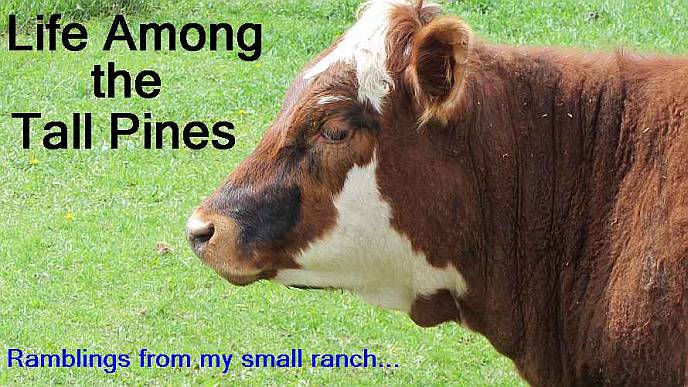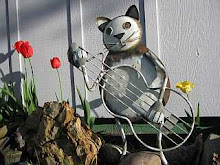Today I cut the grass in my neighbor John's field. He has part of his field east of his house and the larger part west of his house.
Last year I saw some yarrow weeds in the east field so earlier this week I sprayed herbicide on the yarrow. I also found a number of Canada Thistle weeds there, unlike last year. I sprayed those too. All but a handful of weeds were dead when I cut the field today. Last year there were very few weeds in the west field so due to lack of extra time I didn't check this year and spray. When I cut the west field today I saw some scattered Canada Thistle. So I'll have to spray them next year if I cut his field again.
The grass in the east field is fine and on the shorter side and I found the haybine had problems cutting it. The cut grass often would lay on the cutting teeth below where the tines could sweep it up into the conditioning rollers and out the back. This then would impede the teeth and I would get scattered grass not cut. It doesn't provide a "clean look" when the field is done.
Near the beginning of cutting, the grass clogged the teeth and the wobble cutting bar quit moving and then the belt began to smoke. I stopped and cleaned the grass from the haybine and teeth. I had the haybine a bit low to the ground. So I continued with the haybine a little off the ground. But the grass was only getting partially cut. So I lowered the haybine closer to the ground and ended up driving in a lower gear. A lower and slower gear than I drove when I cut my heavy field.
So cutting the east field took much longer than expected.
The grass in the west field, while still on the fine side, was taller and the tines tended to move it to the roller and out the back better. So I could drive in slighter faster gear. For most of the field. One lower corner had really tall and heavy grass so I drove in a lower gear.
The west field also took longer than expected.
I had started cutting shortly after 10 am and expected to be done between 2 and 3 pm. After the main west field was cut I decided to cut a small area off the lower end of the field that had no bushes and tall and thick grass. It was around 3:30 pm and I had about 15-20 minutes of cutting left when the haybine's tines quit turning as I was circling around to make another pass.
The haybine's universal joint had come off. I turned off the tractor's PTO. The haybine's PTO universal joint is made up of two parts. One end attaches to the rod with splines on the haybine. The other end attaches to the tractor's PTO splines. Of the two pieces one slips inside the other. This allows the flexibility of when the tractor turns right and left when the tractor's PTO is operating.
When the haybine's universal joint came off it dropped to the ground. The part attached to the tractor kept spinning until I turned off the PTO. But the damage was done. The "cross" that holds the rod's knuckle to the tractor's knuckle was broken.
The following photo shows the part of the universal joint that attaches to the tractor. For the photo I inserted the "cross" back into the knuckle. It is not 'held' as the "crosses'" caps are broken. (A good cap is seen below in one of the other two parts of the 'cross').
So, on Monday I have to go to a local machine shop that sells U joints. I will have to buy a new "cross", take the bad 'cross" out of the knuckle with the rod, and then insert the new 'cross" into both ends of the knuckle.
But that not all. In case you are wondering... why did the other half of the U joint come off the haybine? The other end was attached to the haybine's spline by three bolts, that when screwed in, pressure against the spine in order to hold it in place. According to my neighbor and friend Wyatt who came over and looked at the pieces, this is not normal. Usually the knuckle's spine has a 'button' that holds it on to the other spline connection. This is how it works when I attach the other end to the tractor's PTO splines. Someone had modified the knuckle to have the three bolts. One bolt loosened and the knuckle came off the haybine's spline.
The U joint's spline at the haybine end is worn and needs replacing - not a fix of three bolts using pressure to keep it on. The haybine's spline is also worn but Wyatt thinks we can make it work with a new knuckle spline and using the existing worn haybine spline. I hope so as the haybine spline is attached to a long shaft that goes all the way to the haybine itself.
This is what one gets when they buy used equipment.
I don't plan on going back to cut the little remaining grass once the haybine is fixed. There is not much left, and getting down a one lane driveway to John's house and through a sharp turn through a gate without hitting anything (like his vehicles sitting there, or the gate) takes care. This something I prefer to only do once a year.
Lastly I have to replace a cutting tooth on the haybine's sickle bar as one tooth is partially broken. To cut the fine grass I had the haybine lower than I wanted in another person's field. I came across two rocks. The first seemed to have been a bump for one haybine tire. The second rock I seen picked up by the rock guards into the haybine where the tines flipped it up and back out. I then quickly stopped the PTO and got out and got the rock and put it off to the side of the field. This rock may have broken the end of the tooth. Though to be fair, when cutting my and John's field I sometimes hears a clanking sound that may have been a smaller rock kicked up and rolled around by the haybine.
Saturday, July 08, 2017
Subscribe to:
Post Comments (Atom)




No comments:
Post a Comment